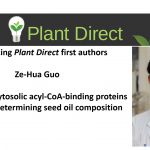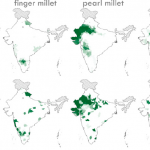Plant Science Research Weekly: December 6
Review. Dare to change, the dynamics behind plasmodesmata-mediated cell-to-cell communication
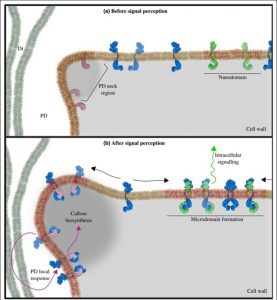 A new review by Petit et al. skillfully highlights the role of plasmodesmata at the interface between cell biology and whole-plant physiology. These tiny channels that connect plant cells determine what moves from cell-to-cell symplastically, so have roles in just about everything, from developmental patterning and timing to defense. Here the authors cover the dynamic nature of plasmodesmata, both in terms of their structures and how they control the movement of signals and other molecules. This review explores the role of callose and structural and regulatory proteins such as Multiple C2 domains and Transmembrane region Proteins (MCTPs) in regulating plasmodesmata conductance, and the consequence of receptor protein localization to and from the plasmodesmata. (Summary by Mary Williams) Curr. Opin. Plant Biol. 10.1016/j.pbi.2019.10.009
A new review by Petit et al. skillfully highlights the role of plasmodesmata at the interface between cell biology and whole-plant physiology. These tiny channels that connect plant cells determine what moves from cell-to-cell symplastically, so have roles in just about everything, from developmental patterning and timing to defense. Here the authors cover the dynamic nature of plasmodesmata, both in terms of their structures and how they control the movement of signals and other molecules. This review explores the role of callose and structural and regulatory proteins such as Multiple C2 domains and Transmembrane region Proteins (MCTPs) in regulating plasmodesmata conductance, and the consequence of receptor protein localization to and from the plasmodesmata. (Summary by Mary Williams) Curr. Opin. Plant Biol. 10.1016/j.pbi.2019.10.009
From plasmodesma geometry to effective symplasmic permeability through biophysical modelling
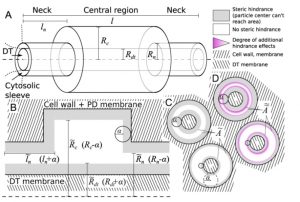 Plasmodesmata are tiny regulated channels that connect adjacent plant cells through which nutrients, signaling molecules and viruses can move. To try to resolve discrepancies between functional and structural studies, Deinum et al. have developed a model for plasmodesmatal permeability that predicts transport data. How do structural variations in plasmodesmata such as neck diameter and the presence of desmotubules affect transport? Are they affected by nearby neighboring plasmodesmata, or does each operate fully independently? The authors base their models on concentric cylinders of various geometries and various degrees of steric hinderance. They consider the flow through single plasmodesmata as well as the effect of cytoplasma surrounding them. Their model can be applied to estimate wall permeability based on measured plasmodesmatal sizes and densities. (Summary by Mary Williams) eLIFE 10.7554/eLife.49000
Plasmodesmata are tiny regulated channels that connect adjacent plant cells through which nutrients, signaling molecules and viruses can move. To try to resolve discrepancies between functional and structural studies, Deinum et al. have developed a model for plasmodesmatal permeability that predicts transport data. How do structural variations in plasmodesmata such as neck diameter and the presence of desmotubules affect transport? Are they affected by nearby neighboring plasmodesmata, or does each operate fully independently? The authors base their models on concentric cylinders of various geometries and various degrees of steric hinderance. They consider the flow through single plasmodesmata as well as the effect of cytoplasma surrounding them. Their model can be applied to estimate wall permeability based on measured plasmodesmatal sizes and densities. (Summary by Mary Williams) eLIFE 10.7554/eLife.49000
Primer: Rhynie chert ($)
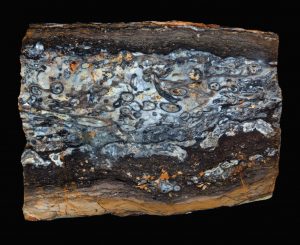 This short Primer by Strullu-Derrien et al. introduces the amazing early vascular plant fossils from the Rhynie chert. The fossils’ high level of detail is a consequence of their being embedded in a glass-like silica matrix, possibly derived from hydrothermal springs. The fossils are approximately 407 million years old, and derive from the earliest stages of vascular development so are invaluable for our understanding of the origins of vascular tissues (although as the authors observe, water-conducting tissues are more evident than phloem). Although known for their unique plant fossils, these Rhynie chert fossils also contain cyanobacteria and green algae, giving a snapshot of a very different green world, as well as fungi, lichen, nematodes and other animals. (Summary by Mary Williams) Curr. Biol. 10.1016/j.cub.2019.10.030
This short Primer by Strullu-Derrien et al. introduces the amazing early vascular plant fossils from the Rhynie chert. The fossils’ high level of detail is a consequence of their being embedded in a glass-like silica matrix, possibly derived from hydrothermal springs. The fossils are approximately 407 million years old, and derive from the earliest stages of vascular development so are invaluable for our understanding of the origins of vascular tissues (although as the authors observe, water-conducting tissues are more evident than phloem). Although known for their unique plant fossils, these Rhynie chert fossils also contain cyanobacteria and green algae, giving a snapshot of a very different green world, as well as fungi, lichen, nematodes and other animals. (Summary by Mary Williams) Curr. Biol. 10.1016/j.cub.2019.10.030
Conversion of Escherichia coli to generate all biomass carbon from CO2
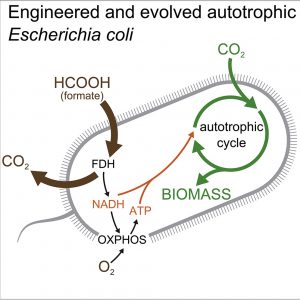 Plants are photosynthetic autotrophs, meaning they use light energy to feed themselves, with carbon dioxide as a carbon source. Heterotrophs like E. coli require organic carbon. Here, Gleizer et al. have rewired the metabolism of E. coli to make it into a (non-photosynthetic) autotroph, meaning it can build organic molecules using only CO2 as a carbon source. It does however require formate (HCOOH) as a source of energy and reducing power. Following the initial rewiring, cells still required xylose and were not autotrophic, so the authors then used a directed evolution approach by providing decreasing amounts of xylose in the growth medium over successive generations until the cells achieved full autotrophy. The authors sequenced the genomes of the autotrophic lines to learn which genetic changes had been selected. (Summary by Mary Williams) Cell 10.1016/j.cell.2019.11.009
Plants are photosynthetic autotrophs, meaning they use light energy to feed themselves, with carbon dioxide as a carbon source. Heterotrophs like E. coli require organic carbon. Here, Gleizer et al. have rewired the metabolism of E. coli to make it into a (non-photosynthetic) autotroph, meaning it can build organic molecules using only CO2 as a carbon source. It does however require formate (HCOOH) as a source of energy and reducing power. Following the initial rewiring, cells still required xylose and were not autotrophic, so the authors then used a directed evolution approach by providing decreasing amounts of xylose in the growth medium over successive generations until the cells achieved full autotrophy. The authors sequenced the genomes of the autotrophic lines to learn which genetic changes had been selected. (Summary by Mary Williams) Cell 10.1016/j.cell.2019.11.009
A new B-BOX containing protein regulates red light photomorphogenesis ($)
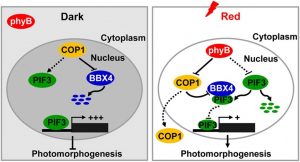 As the primary red light photoreceptor in Arabidopsis, phyB affects various developmental processes, such as seed germination, shade avoidance, etc. PIF3 is a key repressor of phyB-mediated photomorphogenesis that is degraded in red light. Recently Heng et al. identified a positive regulator of red light signaling designated BBX4. In darkness, BBX4 is targeted by COP1 for degradation, but under red light, phyB interferes with COP1’s function thus enhances BBX4’s abundance. BBX4 accumulation in turn inhibits PIF3’s transcription activation, therefore promoting photomorphogenesis. As the authors state, “this evidence supports the conclusion that phyB promotes photomorphogenesis in R light not only by promoting degradation of negative regulators like PIF3, but also by facilitating the accumulation of positive regulators like BBX4.” (Summary by Nanxun Qin) PNAS 10.1073/pnas.1915149116
As the primary red light photoreceptor in Arabidopsis, phyB affects various developmental processes, such as seed germination, shade avoidance, etc. PIF3 is a key repressor of phyB-mediated photomorphogenesis that is degraded in red light. Recently Heng et al. identified a positive regulator of red light signaling designated BBX4. In darkness, BBX4 is targeted by COP1 for degradation, but under red light, phyB interferes with COP1’s function thus enhances BBX4’s abundance. BBX4 accumulation in turn inhibits PIF3’s transcription activation, therefore promoting photomorphogenesis. As the authors state, “this evidence supports the conclusion that phyB promotes photomorphogenesis in R light not only by promoting degradation of negative regulators like PIF3, but also by facilitating the accumulation of positive regulators like BBX4.” (Summary by Nanxun Qin) PNAS 10.1073/pnas.1915149116
RNAseq analysis of the response of Arabidopsis thaliana to fractional gravity under blue-light stimulation during spaceflight
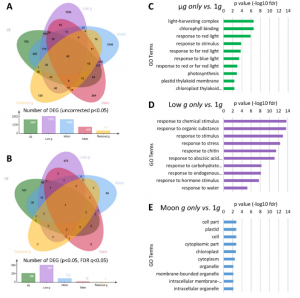 A plant’s response to a microgravity environment allows for dissection of molecular pathways governing gravity sensing and other integrated pathways, such as phototropism. Renewed interest in long-term space travel also requires that plant behavior and growth under microgravity is well-understood and predictable. In this study, Herranz et al. report on the transcriptional changes underlying unilateral blue-light phototropism under six different gravity levels on the International Space Station. Compared to 1g (normal Earth gravity), the group found 12 genes whose transcription changed across the different fractional and microgravity levels tested. Additionally, as the fractional gravity experienced by plants increased, the number and effect size of those genes decreased as the treatment approached 1g. Documenting these transcriptional changes under varying abiotic treatments may pave the way for a better understanding how plants perceive and coordinate a single response to multiple tropic cues. (Summary by Nathan Scinto-Madonich) Front. Plant Sci.10.3389/fpls.2019.01529
A plant’s response to a microgravity environment allows for dissection of molecular pathways governing gravity sensing and other integrated pathways, such as phototropism. Renewed interest in long-term space travel also requires that plant behavior and growth under microgravity is well-understood and predictable. In this study, Herranz et al. report on the transcriptional changes underlying unilateral blue-light phototropism under six different gravity levels on the International Space Station. Compared to 1g (normal Earth gravity), the group found 12 genes whose transcription changed across the different fractional and microgravity levels tested. Additionally, as the fractional gravity experienced by plants increased, the number and effect size of those genes decreased as the treatment approached 1g. Documenting these transcriptional changes under varying abiotic treatments may pave the way for a better understanding how plants perceive and coordinate a single response to multiple tropic cues. (Summary by Nathan Scinto-Madonich) Front. Plant Sci.10.3389/fpls.2019.01529
Rice nitrogen nutrition is improved by association with a fungus carrying nitrogen-fixing endobacteria ($)
 Previously, growth-promoting endophytic (living within the plant) microbes were isolated from plants (narrowleaf cattail, Typha angustifolia) growing in a nutrient-poor site in an effort to identify new beneficial microbes. One of these identified is the fungus Rhodotorula mucilaginosa. Now, Paul et al. have further characterized this fungus to identify how it benefits its host. They found that the fungus carries its own internal helper, a nitrogen-fixing bacterium, Pseudomonas stutzeri. Rice grown in the presence of the bacteria-carrying fungus showed significantly better growth and nitrogen content than in its absence. (Summary by Mary Williams) Plant Cell 10.1105/tpc.19.00385
Previously, growth-promoting endophytic (living within the plant) microbes were isolated from plants (narrowleaf cattail, Typha angustifolia) growing in a nutrient-poor site in an effort to identify new beneficial microbes. One of these identified is the fungus Rhodotorula mucilaginosa. Now, Paul et al. have further characterized this fungus to identify how it benefits its host. They found that the fungus carries its own internal helper, a nitrogen-fixing bacterium, Pseudomonas stutzeri. Rice grown in the presence of the bacteria-carrying fungus showed significantly better growth and nitrogen content than in its absence. (Summary by Mary Williams) Plant Cell 10.1105/tpc.19.00385
Insect-damaged Arabidopsis moves like wounded Mimosa pudica
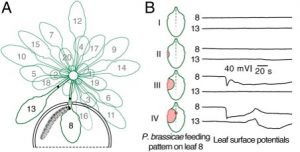 Stroking leaves of the sensitive plant Mimosa pudica causes them to fold inwards, but when touched more aggressively the leaf petioles and petioles of distal untouched leaves collapse dramatically downwards (as seen in this video); the propagating electrical signal is called the slow wave potential. Kurenda et al. investigated the mechanistic underpinnings of this signal, which can also be recorded in wounded Arabidopsis leaves. The authors measured electrical currents and petiole movements in leaves being wounded by caterpillars as well as nearby leaves. They found that midvein damage led to leaf-to-leaf electrical signaling, and that in irregular xylem (irx) mutants the electrical signal was abnormal. As yet, the relative contribution of pressure changes in or around the xylem versus signals carried within the xylem cannot be ascertained. (Summary by Mary Williams) Proc. Natl. Acad. Sci USA
Stroking leaves of the sensitive plant Mimosa pudica causes them to fold inwards, but when touched more aggressively the leaf petioles and petioles of distal untouched leaves collapse dramatically downwards (as seen in this video); the propagating electrical signal is called the slow wave potential. Kurenda et al. investigated the mechanistic underpinnings of this signal, which can also be recorded in wounded Arabidopsis leaves. The authors measured electrical currents and petiole movements in leaves being wounded by caterpillars as well as nearby leaves. They found that midvein damage led to leaf-to-leaf electrical signaling, and that in irregular xylem (irx) mutants the electrical signal was abnormal. As yet, the relative contribution of pressure changes in or around the xylem versus signals carried within the xylem cannot be ascertained. (Summary by Mary Williams) Proc. Natl. Acad. Sci USA
Phage combination therapies for bacterial wilt disease in tomato ($)
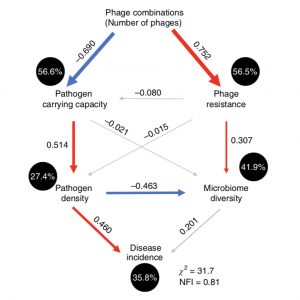 Bacteriophages are viruses that infect bacteria. As agents that weaken or destroy pathogens, they have shown therapeutic promise in human and plant disease treatment. Wang et al. studied the effect on pathogenic Ralstonia solanacearum of different phages individually and in combinations in the rhizosphere of host tomato plant. They conducted experiments in the greenhouse and also in field conditions. They found a combinations of phages to be more effective on reduction of disease than individual phage. The effect on the rhizosphere microbiome was also analyzed during this study and found that the changes in microbiome composition can be driven by indirect feedback mechanism of interaction between phages and pathogenic bacteria. Moreover, the host specificity of phages makes it possible to solely eradicate pathogenic bacteria from the field without hampering plant health. This study supported the use of phages as a precision tool to improve plant protection against pathogenic bacteria. (Summary by Mugdha Sabale) Nature Biotech 10.1038/s41587-019-0328-3
Bacteriophages are viruses that infect bacteria. As agents that weaken or destroy pathogens, they have shown therapeutic promise in human and plant disease treatment. Wang et al. studied the effect on pathogenic Ralstonia solanacearum of different phages individually and in combinations in the rhizosphere of host tomato plant. They conducted experiments in the greenhouse and also in field conditions. They found a combinations of phages to be more effective on reduction of disease than individual phage. The effect on the rhizosphere microbiome was also analyzed during this study and found that the changes in microbiome composition can be driven by indirect feedback mechanism of interaction between phages and pathogenic bacteria. Moreover, the host specificity of phages makes it possible to solely eradicate pathogenic bacteria from the field without hampering plant health. This study supported the use of phages as a precision tool to improve plant protection against pathogenic bacteria. (Summary by Mugdha Sabale) Nature Biotech 10.1038/s41587-019-0328-3
Assessing the sustainability of post-Green Revolution cereals in India
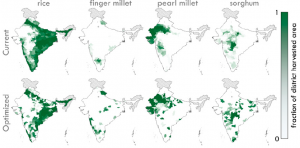 The major objectives of sustainable agriculture are to fulfill food requirements, maintain a safe environment and profitable economy, and withstand climate change. Here, Davis et al. discuss a multidimensional approach to achieve sustainable agriculture in India by transitioning some areas from growing rice to growing coarse grains such as sorghum and millet (also known as Nutri-Cereals). In addition to increasing crop productivity, the authors considered other factors like nutrient status (including protein and iron content), greenhouse gas emissions, resource requirements (manure, fertilizer, labor, energy) and resilience to climate. When considering all of these dimensions, the authors observed a substantial increase in the overall productivity of coarse cereals without impacting the environment in few southern and eastern states of India, but in other regions very minimal to no effect. This suggested that coarse cereals could be beneficial in that it could reduce dependence on synthetic fertilizer and labor input. This transition needs changes in a) policies, b) development of more varieties, c) trading of coarse cereals among the different states and d) evaluation of sustainable methods to cultivate coarse cereals. This study shows that some transitioning from rice to coarse cereal production could meet the food demands and nutrient requirements through a more environmentally friendly and resilient cropping system. (Summary by Suresh Damodaran). Proc. Natl. Acad. Sci. USA 10.1073/pnas.1910935116
The major objectives of sustainable agriculture are to fulfill food requirements, maintain a safe environment and profitable economy, and withstand climate change. Here, Davis et al. discuss a multidimensional approach to achieve sustainable agriculture in India by transitioning some areas from growing rice to growing coarse grains such as sorghum and millet (also known as Nutri-Cereals). In addition to increasing crop productivity, the authors considered other factors like nutrient status (including protein and iron content), greenhouse gas emissions, resource requirements (manure, fertilizer, labor, energy) and resilience to climate. When considering all of these dimensions, the authors observed a substantial increase in the overall productivity of coarse cereals without impacting the environment in few southern and eastern states of India, but in other regions very minimal to no effect. This suggested that coarse cereals could be beneficial in that it could reduce dependence on synthetic fertilizer and labor input. This transition needs changes in a) policies, b) development of more varieties, c) trading of coarse cereals among the different states and d) evaluation of sustainable methods to cultivate coarse cereals. This study shows that some transitioning from rice to coarse cereal production could meet the food demands and nutrient requirements through a more environmentally friendly and resilient cropping system. (Summary by Suresh Damodaran). Proc. Natl. Acad. Sci. USA 10.1073/pnas.1910935116
Antimicrobial solid media for screening non-sterile Arabidopsis thaliana seeds
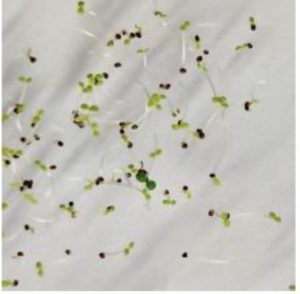 Transgenic plant production often involves an agar-based selection step in which plants that have taken up the introduced DNA (containing a selectable marker) show resistance to a corresponding antibiotic. Typically, putatively transformed seeds are surface sterilized prior to plating so that microbes don’t outgrow the much slower-growing plants. This step is time consuming and can damage the seeds, making it a bottleneck in the process. Now, Behrendorff et al. have found that simply including additional antibiotics in the plating medium is sufficient to prevent microbial growth and eliminate the surface sterilization step, and that the cocktail they have developed does not interfere with seed germination or seedling growth. (Summary by Mary Williams) bioRxiv 10.1101/852020
Transgenic plant production often involves an agar-based selection step in which plants that have taken up the introduced DNA (containing a selectable marker) show resistance to a corresponding antibiotic. Typically, putatively transformed seeds are surface sterilized prior to plating so that microbes don’t outgrow the much slower-growing plants. This step is time consuming and can damage the seeds, making it a bottleneck in the process. Now, Behrendorff et al. have found that simply including additional antibiotics in the plating medium is sufficient to prevent microbial growth and eliminate the surface sterilization step, and that the cocktail they have developed does not interfere with seed germination or seedling growth. (Summary by Mary Williams) bioRxiv 10.1101/852020


